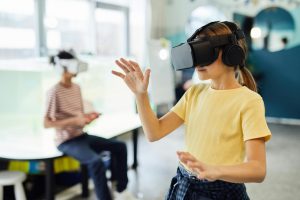Addressing digital classrooms through technology in education
Technology has completely transformed the education sector, changing the way students learn and teachers teach. One of the most significant changes brought about by technology is the introduction of digital classrooms. These digital classrooms, equipped with various technological tools and resources, have become an essential part of modern-day education. As we continue to navigate through the digital age, it is crucial to address the role of technology in education and how it can help us enhance the learning experience in digital classrooms. This article will delve into the various ways technology is addressing digital classrooms in education and the benefits it offers for both students and teachers.
The Rise of Digital Classrooms
The traditional classroom setup, with its rows of desks and a teacher lecturing upfront, has undergone a massive transformation with the incorporation of technology. Digital classrooms are essentially traditional classrooms with an added layer of technology. These classrooms use devices such as laptops, tablets, and interactive whiteboards to deliver instructional content and engage students in learning. They also provide access to online resources, educational applications, and collaboration tools that facilitate learning beyond the four walls of a physical classroom.
Enhanced Interactivity and Engagement
Digital classrooms have made learning more interactive and engaging for students. With interactive whiteboards, students can participate actively in lessons by writing, drawing, and solving problems. They can also collaborate with their peers and teachers through online platforms, breaking the monotony of traditional teacher-centered lessons. This increased interaction and engagement in the learning process can significantly improve students’ understanding and retention of information.
Personalized Learning Experience
One of the most significant benefits of digital classrooms is the ability to personalize the learning experience for each student. With the help of educational apps and online resources, teachers can customize the content and pace of lessons to meet the needs and learning styles of individual students. This not only caters to students with different abilities but also provides a more engaging and effective learning experience for all students.
The Role of Technology in Addressing Digital Classrooms
Access to Information and Resources
Technology has opened up endless possibilities for students to access information and educational resources. With the internet, students can access a vast amount of information and educational materials, helping them learn beyond what is taught in the classroom. This access to information also allows for self-directed learning, where students can explore their interests and expand their knowledge on various subjects.
Collaboration and Communication
Digital classrooms have also brought about a significant improvement in collaboration and communication among students and teachers. Through online platforms and tools, students can work on group projects, share ideas, and seek feedback from their peers and teachers. This not only enhances their teamwork skills but also promotes effective communication, an essential skill in today’s digital world.
Efficient and Effective Assessment
Technology has made the assessment process more efficient and effective for teachers. With the use of online quizzes and tests, teachers can quickly assess students’ understanding of a topic. This not only saves time but also provides immediate feedback to students, allowing for continuous improvement. Technology also allows for the tracking of students’ progress, making it easier for teachers to identify areas that need more attention.
The Future of Digital Classrooms
The future of digital classrooms looks promising, with technology continuously evolving and offering new tools and resources for education. Virtual reality and artificial intelligence are just some of the emerging technologies that have the potential to transform digital classrooms further. Virtual reality, for instance, can provide immersive learning experiences, while artificial intelligence can personalize learning to a whole new level. These technologies will undoubtedly enhance the overall learning experience for students and teachers in digital classrooms.
Conclusion
In conclusion, technology has played a significant role in addressing digital classrooms in education. From enhancing interactivity and engagement to providing access to information and resources, technology has revolutionized the traditional classroom setup. With its many benefits, it is clear that technology will continue to shape the future of education, making learning more effective, efficient, and engaging for students and teachers alike.










